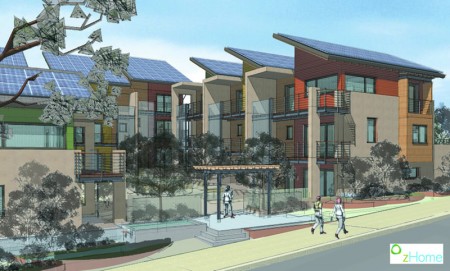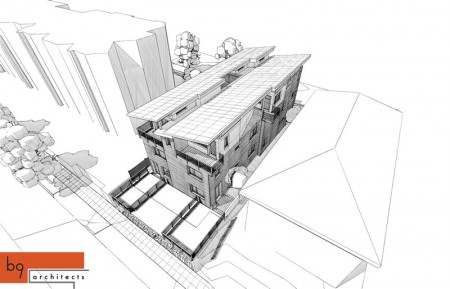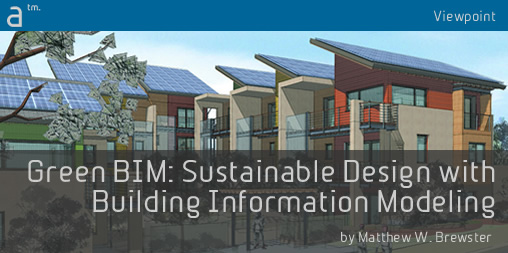Sustainable, or green design, are buzzwords of contemporary architecture. For reasons that vary from meeting energy codes, managing increasing fuel costs, reducing waste, expression of personal values, or the desire for self-sufficiency, more people are thinking green. How can Building Information Modeling (BIM) help to design better “green buildings”?
Challenges in the Pacific Northwest
The regions of western Oregon and Washington State have unique challenges when it comes to green design. For a good part of our winter months we receive little direct sunlight when we could use it the most. Raw materials are also becoming more expensive and construction waste is at an all time high. Even in parts of the country with these challenges, BIM can be used to optimize solar and energy efficient design and minimize waste.
Green Design with BIM
The thoughtful designer can use BIM models to save resources AND money for project owners by incorporating analytical studies into the early design phase.
Analytical sun studies
Conducting a sun study helps the designer to evaluate and refine his project to effectively use daylight sources.
Continuous control of usage of resources
Quantities and detailed data about building components can be generated, providing the architect and the owner with valuable information about the materials used.
What-if scenarios for design optimization
The ability to run different scenarios supports the green design process.
Computer energy simulations
Computer energy simulation is used throughout the design process to assess the building’s energy conservation value and construction costs.
Architects and engineers can collaborate to generate many alternative concepts for building form, envelope, and landscaping. This allows focus on minimizing peak energy loads, demand, and consumption.
Typically, heating and cooling load reductions from shading devices, better glazing, insulation, efficient lighting, daylighting, and active and passive solar systems allow for smaller and less expensive HVAC equipment which, when well designed, can result in little or no increase in construction cost compared to conventional designs. Simulations are used to refine designs and ensure that energy-conservation and capital cost goals are met and to demonstrate compliance with regulatory requirements.

01 - David Vandervort Architects -- Located in Issaquah, Washington, zHome is the first multifamily, production, zero-energy, carbon neutral community in the United States. In addition to presentation images and construction documentations, BIM was used to create sun studies which helped shape the roofs. URL: http://www.vandervort.com
BIM as Collaborative Foundation
Effective green designs use the BIM model as a basis for measuring the various performance analyses. The BIM approach provides an optimal collaborative environment for specialized applications.
Developers of BIM applications have become one of the leading forces behind interoperability standards such as the Industry Foundation Classes (IFC), which allows sharing and exchange of the 3D model’s information for generating building simulations across multiple applications.
As a result of this interoperability, the BIM model functions as a fulcrum around which everything else pivots – from structural engineering applications to collision detection, building performance and energy analysis regardless of the software manufacturer.
Data Sharing
Using the BIM model as the data backbone for the process, energy analysis software such as IES, ECOTECT and EnergyPlus in North America or VIP and RIUSKA in Europe can contribute valuable data to a project. Primarily used by engineers, this software can be used to optimize systems such as solar, thermal, lighting and HVAC. EnergyPlus and RIUSKA users can take advantage of IFC compatibility for a smooth collaboration with the BIM application. Green Building XML (gbXML) is used for connections with Green Building Studio, ECOTECT, and IES Virtual Environment.

02 - b9 Architects -- Currently in design, this 4-unit development in Seattle, Washington, seeks to achieve zero energy usage and/or the PassivHaus Institute certification. Throughout the process BIM and energy modeling has been utilized as a way of evaluating the design. Strategically oriented site planning, roof slopes for solar photovoltaics and clerestories, glazing percentages, building envelope and wall thickness have been carefully examined in BIM. URL: http://www.b9architects.com
So what tools are available for architects who want to quickly evaluate design options right at the initial design stage?
Energy Analysis within a BIM Model
Energy consumption is one of the main contributors to a building’s air pollution and maintenance cost. Graphisoft has developed the tools that work within a BIM model to generate energy reports early in the design phase when the architect has the greatest opportunity to influence the efficiency of a project.
Advertisement
EcoDesigner is a new plug-in for Graphisoft’s BIM application, ArchiCAD. As soon as a design takes shape, comparative energy reports can be generated with a click. The resulting reports give feedback about the buildings energy usage, yearly utility costs, and carbon footprint. (ed. note: see Architosh’s interview article: “AIA: Talking to Viktor Varkonyi about EcoDesigner,”
This changes the essence of energy analysis from a formal checking stage at the end of the design process when it is often too late to be an effective design tool. Ideally, energy analysis should be integrated from the start of a project.
Final Thoughts
At a time when economical use of resources is critical, to the survival of the building trades and, potentially, to the survival of human and biotic communities, it makes sense to take a new look at how we create efficient buildings. The technology is available today to help architects find the best solution. And as the demand for “more green” increases, developers will expand these analytical tools to take advantage of the power of BIM.
One more thing. While you are designing the greenest buildings, why not do it on one of the world’s greenest computers? In addition to their power and ease of use, Apple’s lineup of notebooks are energy efficient and built with the environment in mind.
To learn more about BIM and Green Design contact Matthew W. Brewster, founder of BIMiDEAS at: http://www.bimideas.biz/
About Viewpoint Articles: Viewpoint articles are features contributed by industry professionals across the entire range of disciplines covered by Architosh. They are aimed at being “instructional” or “position papers” directed at advantages of technologies, configurations, services, or solutions. They are authored by industry professionals who are directors, providers, experts, teachers and thought-leaders within their industry. To inquire about contributing a Viewpoint article please email us at: info@architosh.com





Reader Comments
[…] Original post: Green BIM: Sustainable Design with Building Information Modeling … […]
[…] Green BIM: Sustainable Design with Building Information Modeling … By Matthew Brewster 02 – b9 Architects — Currently in design, this 4-unit development in Seattle, Washington, seeks to achieve zero energy usage and/or the PassivHaus Institute certification. Throughout the process BIM and energy modeling has been … Architosh – https://architosh.com/ […]
This is an excellent Viewpoint that touches down on several key ideas central to understanding BIM and its benefits. I find it interesting mentioning that in the Pacific Northwest where daylight is minimal we find architecture firms pushing aggressively ahead with “green design” and energy-conservative oriented design like DVA and b9Architects.
It was also interesting to hear about the Passivhaus Institute certification and to read up on the requirements for this certification dealing with “passive house” heating and cooling methodologies and the requirements for buildings in the 40-60-degree Northern latitudes.
[…] Read the full article at architosh .. […]
[…] Green BIM: Sustainable Design with Building Information Modeling […]
Comments are closed.